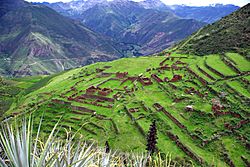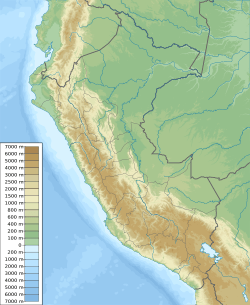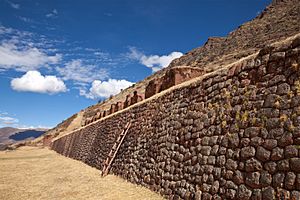Huchuy Qosqo facts for kids

Huchuy Qosqo overlooking the Sacred Valley.
|
|
| Alternative name | Qaqyaqawana |
|---|---|
| Location | Lamay District. Calca Province, Cusco Region, Peru |
| Coordinates | 13°21′59″S 71°56′42″W / 13.3663°S 71.9451°W |
| Type | Settlement |
| History | |
| Founded | 1420 CE |
| Cultures | Inca Empire |
Huchuy Qosqo is an ancient Inca site in Peru. It is located north of the city of Cusco. In the Quechua language, its name means "Little Cusco."
This special place sits high up at about 3,650 meters (11,975 feet). It offers amazing views of the Sacred Valley. It is about 3 kilometers (1.9 miles) west of the town of Lamay. The site got its current name in the 20th century. Long ago, it was known as Kakya Qawani or Caquia Xaquixaguana.
Historians believe that Inca Emperor Viracocha built Huchuy Qosqo around 1420 CE. It was likely his royal country home.
Contents
What Was Huchuy Qosqo?
The first buildings at Huchuy Qosqo were made between 1000 and 1400 CE. In the early 1400s, Emperor Viracocha made it his royal estate. An Inca royal estate was like a large country palace. It was also a center for government and a place to grow food.
Inca leaders built these estates to become more powerful and wealthy. Their families would inherit these estates. Huchuy Qosqo was called "Little Cusco" because it was a smaller version of the Inca capital city.
Who Worked at the Estate?
To build and run Huchuy Qosqo, Viracocha needed many workers. The Inca Empire had a system called mit'a. This meant people had to work for the empire instead of paying taxes. Most workers for the estate came from nearby groups. Skilled workers might have been brought from other areas.
Another way the Incas got workers was through a policy called mitma. This involved moving families or whole groups of people to new lands. This helped the Incas keep control. It also made it harder for different groups to team up against them.
Some people were permanent servants called yanakuna. They worked directly for the Incas. Sometimes, yanakunas even became important leaders.
There were also aqllakuna, who were women who lived together. They made textiles (cloth), which was very important to the Inca economy. They also made chicha, a fermented drink used at feasts.
These different groups of people provided the labor for the royal estates. These estates could manage huge areas of farmland and mines. They also had factories for making textiles.
A Place of Refuge
Late in his rule, Emperor Viracocha faced a rebellion. He went to Huchuy Qosqo for safety. He left his son, Pachacuti, to defend Cusco. Pachacuti stopped the rebellion. He then became the new Emperor (from 1438 to 1471).
Huchuy Qosqo was made even bigger after Viracocha was no longer emperor. Scientists have found that construction happened there between 1420 CE and 1530 CE. Later, around 1534, a Spanish explorer named Gonzalo Pizarro looted Huchuy Qosqo.
Exploring the Ancient Site
The site has many buildings made of stone and adobe (mud bricks). One large building, called a kallanka, is 40 meters (131 feet) long. The Incas also built an irrigation channel to bring water to the site. It is lined with stones and is about 800 meters (2,625 feet) long.
After the Inca rule, the Spanish took over Huchuy Qosqo in the 1500s. They used the site as a farm. The Incas had built small reservoirs for water. The Spanish later destroyed some Inca buildings to make a larger reservoir.
Below the main Huchuy Qosqo site, you can find restored storehouses called qolqas. These were used to keep dried meat and crops like corn, potatoes, and quinoa cool. They had a special cooling system.
Today, you cannot reach Huchuy Qosqo by public road. You can only get there by hiking or riding a horse. One way is a steep 3-hour hike from Lamay. Another route is a 4- to 6-hour hike from Tauca, Peru. This path goes up to a high pass at 4,400 meters (14,436 feet) before going downhill. Many tour groups offer trips to Huchuy Qosqo.
Images for kids
See also
 In Spanish: Huch'uy Qusqu para niños
In Spanish: Huch'uy Qusqu para niños





